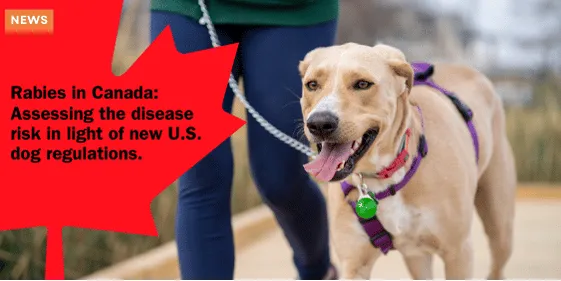Rabies in Canada: Assessing the disease risk in light of new U.S. dog regulations.

Anúncios
Understanding the Implications of Updated U.S. Policies on Canine Rabies Control in Canada
While Health Minister Mark Holland advocates for Canada’s exemption from the United States’ stringent new dog regulations at the border, experts caution that rabies continues to pose a significant domestic threat.
If left untreated, rabies is invariably fatal.
Anúncios
Although the incidence of rabies-positive animals in Canada has diminished since 2000, largely due to effective control programs, infections persist, primarily among bats, skunks, raccoons, and foxes.
Rabies, fatal to humans, remains rare in Canada, but vigilance is necessary.
Anúncios
The U.S. Centers for Disease Control and Prevention (CDC) is instituting new regulations that require pet owners to complete paperwork prior to their visit.
These documents, accessible on the CDC website, must certify that the dog is healthy, has a valid microchip, and is vaccinated against rabies.
Rabies spreads through the body by traveling via peripheral nerves from the site of the bite to the brain, where it induces severe inflammation, leading to neurological symptoms and death if untreated, as explained by Dr. Isaac Bogoch to Global News.
Historical Context of Rabies in Canada
Since 1924, Canada has reported 26 cases of rabies in humans across six provinces, with all of them being fatal, according to Health Canada data.
This alarming statistic highlights the lethal nature of rabies and the significant health risks it continues to pose despite the current low incidence rate in the country.
Historically, rabies was a major public health concern, especially in rural areas where encounters with wildlife, such as raccoons, bats, and skunks, were more frequent.
The 26 cases of rabies in humans serve as a stark reminder of the importance of maintaining strict rabies control measures and public health surveillance.
Despite advances in vaccination programs for animals and the introduction of post-exposure prophylaxis (PEP) for humans, rabies remains a critical issue, and continued vigilance is necessary.
Canada’s success in controlling the disease can be attributed to extensive vaccination programs for both pets and wildlife, but the risk is not completely eliminated.
Therefore, rabies awareness, prevention, and rapid response remain central to public health strategies, especially given the interconnectedness of human, animal, and environmental health.
Rabies and Dogs
Rabies remains a threat to both human and animal populations, particularly through the potential transmission by dogs.
In light of this, the U.S. has recently implemented tighter restrictions on canines entering the country, including those from Canada, effective August 1.
This decision stems from the global efforts to minimize rabies transmission, as the U.S. has designated 131 countries as high-risk areas for rabies, excluding Canada.
As a result, Canadian authorities are advocating for an exemption from these new regulations, given the country’s relatively low incidence of the virus in domestic pets.
While rabies is not commonly found in Canada’s dog population due to robust vaccination campaigns, the disease still poses a risk. Dr. Nicola Schaefer, a staff veterinarian at the Winnipeg Humane Society, stresses that rabies continues to circulate in wildlife, particularly bats, which can then pass the virus onto dogs through bites.
The Canadian Veterinary Medical Association strongly recommends rabies vaccination for all dogs, including those kept indoors, as rabid bats and other wildlife, such as skunks and raccoons, can gain access to homes.
This serves as a critical reminder that rabies is a preventable disease, and vaccination is key to safeguarding both pets and humans.
What to Do If an Animal Bites You
Dr. Isaac Bogoch, an infectious disease expert, emphasizes the urgency of seeking immediate medical attention following any animal bite, regardless of how minor it might appear.
Rabies is a serious and often fatal disease once symptoms appear, but if treated promptly, it can be prevented. This makes timely medical care absolutely critical after exposure to potentially rabid animals.
The first step after a bite is to thoroughly clean the wound with soap and water, as this can reduce the likelihood of infection.
Following this, individuals should seek medical attention immediately for a proper assessment and potential administration of post-exposure prophylaxis (PEP), which consists of a series of rabies vaccinations.
The effectiveness of PEP diminishes once symptoms of rabies begin to develop, which is why immediate intervention is so crucial.
It’s important to remember that rabies can be transmitted by any mammal, so bites from wild animals, pets, or livestock should all be treated with the same level of concern.
Rabies prevention through vaccination is essential, and awareness of the immediate steps to take in the event of a bite can make a critical difference in saving lives.
Rabies Symptoms
Rabies symptoms typically begin to manifest within three to eight weeks of exposure, although the incubation period can vary widely, ranging from a few days to several months.
According to Health Canada, early symptoms can include fever, fatigue, headaches, irritability, and anxiety, often mimicking flu-like conditions.
As the disease progresses, neurological symptoms such as confusion, agitation, hallucinations, and paralysis may develop. Once these symptoms appear, the disease rapidly progresses, and death usually occurs within seven to 14 days due to respiratory failure.
The virus attacks the central nervous system, traveling from the site of the bite or scratch through the peripheral nerves to the spinal cord and brain, where it replicates.
In advanced stages, the patient may experience hydrophobia (fear of water), difficulty swallowing, and seizures.
The severity of symptoms emphasizes the importance of early intervention and treatment, as rabies is nearly always fatal once symptoms appear.
This underscores the necessity for preventative measures such as vaccination and immediate post-exposure prophylaxis (PEP) in order to stop the virus before it reaches the stage where symptoms become visible and irreversible damage occurs.
How to Protect Yourself
Vaccination remains the most effective means of preventing rabies, particularly for individuals traveling to high-risk countries or working with animals that could potentially carry the virus.
The federal government strongly recommends rabies vaccines for people in specific high-risk categories, such as veterinarians, laboratory workers handling the rabies virus, and those traveling to countries with widespread rabies in dogs.
Additionally, taking preventive measures such as avoiding contact with wild or unfamiliar animals, especially those exhibiting unusual behavior, is critical.
It’s essential to refrain from handling sick or dead animals, as they are more likely to transmit the virus. Parents should supervise children closely around animals, as young children are more prone to mishandling or trying to pet wild animals, increasing their risk of exposure.
Furthermore, regular vaccination of pets and livestock plays a crucial role in preventing the spread of rabies. Pet owners should ensure their dogs, cats, and other animals are vaccinated as per local regulations.
Reporting any wild animal exhibiting abnormal behavior to public health authorities is also an important step in reducing the risk of rabies transmission.
By taking these precautions, individuals can significantly reduce their risk of contracting rabies and contribute to the broader efforts of preventing its spread.
Conclusion
In conclusion, while Canada’s risk of rabies remains low, the potential threat persists, necessitating ongoing vigilance and adherence to control measures.
The new U.S. dog regulations aim to mitigate the risk of rabies transmission through international canine travel, highlighting the importance of continued cooperation and compliance with health guidelines.
By understanding the implications of these updated U.S. policies and maintaining robust rabies control strategies, Canada can effectively safeguard public health against this fatal disease.






